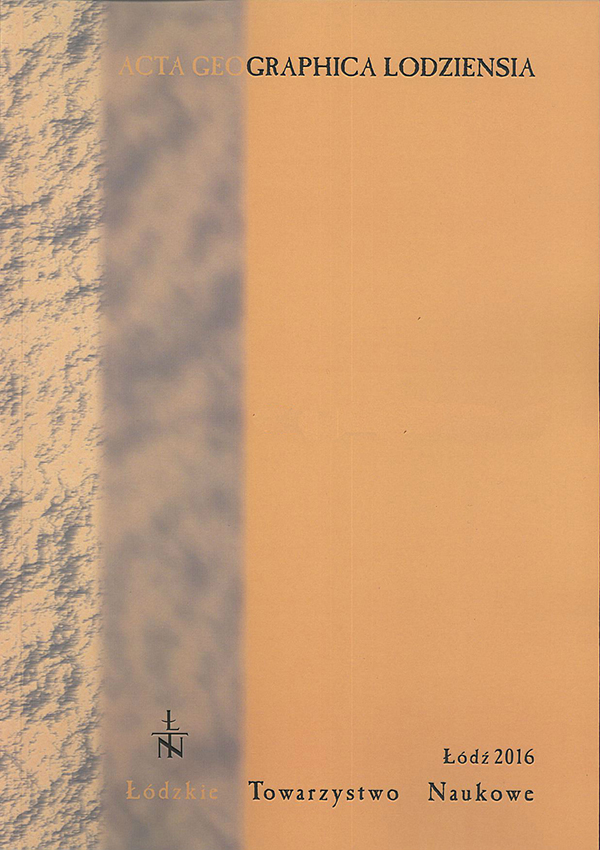Pojezierze eemskie: uwagi o genezie i zaniku jezior polodowcowych centralnej Polski
Eemian lakeland: remarks on origin and decline of the post-glacial lakes in Central Poland
Author(s): Małgorzata RomanSubject(s): Geography, Regional studies, Environmental Geography
Published by: Łódzkie Towarzystwo Naukowe
Keywords: subfossil lakes, Eemian interglacial; Vistulian; palaeolandscape; Central Poland
Summary/Abstract: The ice sheet recession from the preEemian glaciation left a lakeland the traces of which we see inthe sediments of lake basins forming at that time (Fig. 1). In Central Poland recognized are 58 sites offossil lake and bog sediments with palynologically documented Eemian interglacial flora but also inother 30 sites that can be deemed as Eemian (cf. Fig. 1, Tab. 1). They mostly are infillings of old depressionsappearing at the end of the Warta stadial (Late Saalian glaciation, MIS 6) seen as kettle holes(ca 90%). Glacial troughs and fossil oxbows fillings are rare. Reservoirs with incessant lake-bog sedimentsaccumulation in Eemian interglacial and the subsequent cold Vistulian period are infrequent. Thelongest continuous record of postEemian environmental changes is found at the Kubłowo (Roman, Balwierz2010; Niska, Roman 2014; Mirosław-Grabowska et al. in press) and Zgierz-Rudunki sites (Jastrzębska-Mamełka 1985) (Fig. 2).Till concavities with lake-bog Eemian-Vistulian series are relics of a postWartanian landscapepreserved by younger deposits. Reconstruction of the postglacial relief is intractable when one considersthe subsequent transformations, alignments of the glacial plateaus and the accompanying aggradationin the different types of depressions. However, taking into account the frequency of fossil lakesbest recognized in the Bełchatów outcrops, the Konin region and in the Łódź area, we can postulatethat the said lake frequency is comparable to the contemporary lakelands in the North of Poland. Thuswe may speak of a fossil Eemian lakeland in Central Poland. Its southern limit corresponds to the pre-Eemian, i.e. the Warta Stadial, ice sheet extent (cf. Bruj, Roman 2007). Analysis of the distribution of subfossil Eemian flora sites in relation to the origin of palaeolakes,the nature of their infillings and palaeolandscape we tend to formulate some remarks:– The best chance to survive with a long-lasting functioning had reservoirs situated over 200 ma.s.l. along the watershed said by Dylikowa (1973) to be the Łódź Ridge that had a similar course as inthe pre-Eemian surface (Turkowska 2006). Those reservoirs lasted long, if at all, in a closed systemand were not part of the Vistulian surface drainage.– Fossil reservoirs with a marked elongation and depth which origin can be found in subglacialwater erosion are North of the Kutno moraine arc formed during Warta stadial ice sheet recession.Such a placement of glacial troughs may indicate that an intensive subglacial drainage system openedonly during that stage.– The palaeobotanic content from particular sites, mostly from those in the northern part of thearea allows to believe that Central Poland during cold stadials of the Early Vistulian (MIS 5d, MIS 5b)and the outstart of the Plenivistulian (MIS 4) found itself at the far forefront of the ice cover (cf. Tobolski1991; Stankowski et al. 1999; Roman 2010; Roman, Balwierz 2010; Roman et al. 2014; Markset al. in press).It remains an open question to determine how the duration of infilling the lake basins and the decayof the lakeland. According to Więckowski (1966, 1968), assuming that lakes that appeared followingthe recession of the ice sheet slowly built their sediments, that process must have protracted for50 000 yrs. From palynology at Kubłowo (Roman, Balwierz 2010) and preliminary investigation at Parchliny (Wachecka-Kotkowska et al. in press) we may accept that the process could have lasted foreven ca 80 000 yrs., knowing that the lake-bog accumulation has begun since the end of Warta stadial (ca 135–130 ka BP) and lasted to the lower part of the middle Plenivistulian (ca 58–53 ka BP). It isworth noting that the series of lake-bog sediments at Kubłowo ends up with an erosional surface (Fig.2), hence it is plausible that the accumulation of sediments along with filling in the reservoir couldhave been significantly longer.
Journal: Acta Geographica Lodziensia
- Issue Year: 2016
- Issue No: 105
- Page Range: 11-25
- Page Count: 15
- Language: Polish

